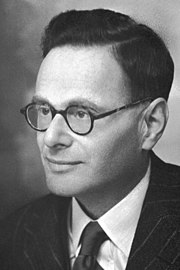Hans Adolf Krebs
| Sir Hans Adolf Krebs | |
|---|---|
 |
|
| Born |
25 August 1900 Hildesheim, Germany |
| Died | 22 November 1981 (aged 81) Oxford, England |
| Citizenship | Naturalised British (from 1939) |
| Nationality | German |
| Fields | Internal medicine, biochemistry |
| Institutions |
Kaiser Wilhelm Institute for Biology University of Hamburg University of Cambridge University of Sheffield University of Oxford |
| Alma mater |
University of Göttingen University of Freiburg University of Berlin University of Hamburg |
| Known for |
Krebs cycle Krebs–Henseleit solution Krebs-Henseleit cycle Glyoxylate cycle |
| Notable awards |
Albert Lasker Award for Basic Medical Research (1953) Nobel Prize in Physiology or Medicine (1953) Royal Medal (1954) Copley Medal (1961) |
| Spouse | Margaret Cicely Fieldhouse (m. 1938) |
| Children | Paul, John, and Helen |
Sir Hans Adolf Krebs (English /krɛbz/ or /krɛps/) (25 August 1900 – 22 November 1981) was a German-born British physician and biochemist. He was the pioneer scientist in study of cellular respiration, a biochemical pathway in cells for production of energy. He is best known for his discoveries of two important chemical reactions in the body, namely the urea cycle and the citric acid cycle. The latter, the key sequence of metabolic reactions that produces energy in cells, often eponymously known as the "Krebs cycle", earned him a Nobel Prize in Physiology or Medicine in 1953. With Hans Kornberg, he also discovered the glyoxylate cycle, which is a slight variation of the citric acid cycle found in plants, bacteria, protists, and fungi.
Krebs was born in Hildesheim, Germany, to Georg Krebs, an ear, nose, and throat surgeon, and Alma Krebs (née Davidson). He was the middle of three children, older sister Elisabeth and younger brother Wolfgang. He attended the famous old Gymnasium Andreanum in his home town. Before completing his secondary school education (by six months) he was conscripted into the Imperial German Army in September 1918, during World War I. He was allowed to appear in an emergency examination for the higher school leaving certificate, which he passed in such a good grade that he suspected the examiners of being “unduly lenient and sympathetic”. The war ended after two months and his conscription ended. He decided to follow his father's profession and entered the University of Göttingen in December 1918 to study medicine. In 1919 he transferred to the University of Freiburg. In 1923 he published his first technical paper on tissue staining technique, the study which he started under the guidance of his teacher Wilhelm von Mollendorf in 1920. He completed his medical course in December 1923. To obtain a medical licence he spent one year at the Third Medical Clinic in the University of Berlin. By then he turned his ambition from becoming a practising physician to medical researcher, particularly towards chemistry. In 1924 he studied at the Department of Chemistry at the Pathological Institute of the Charité Hospital, Berlin, for informal training in chemistry and biochemistry. He finally earned his M.D. degree in 1925 from the University of Hamburg.
...
Wikipedia
